check engine JEEP LIBERTY 2008 KK / 2.G Owner's Manual
[x] Cancel search | Manufacturer: JEEP, Model Year: 2008, Model line: LIBERTY, Model: JEEP LIBERTY 2008 KK / 2.GPages: 493
Page 414 of 493

Operation of the wipers on dry glass for long periods
may cause deterioration of the wiper blades. Always use
washer fluid when using the wipers to remove salt or dirt
from a dry windshield.
Avoid using the wiper blades to remove frost or ice from
the windshield. Make sure that they are not frozen to the
glass before turning them on to avoid damaging the
blade.
Keep the blade rubber out of contact with petroleum
products such as engine oil, gasoline, etc.
NOTE:Always refer to the wiper blade packaging for
specific installation instructions. Many wiper blade re-
placements fit multiple vehicles.Windshield & Rear Window Washers
The windshield and rear window washers share the same
fluid reservoir. The fluid reservoir is located in the front
of the engine compartment. Be sure to check the fluid
level in the reservoir at regular intervals. Fill the reservoir
with windshield washer solvent (not radiator antifreeze)
and operate the system for a few seconds to flush out the
residual water.
When refilling the washer fluid reservoir, take some
washer fluid and apply it to a cloth or towel and wipe
clean the wiper blades, this will help blade performance.
To prevent freeze-up of your windshield washer system
in cold weather, select a solution or mixture that meets or
exceeds the temperature range of your climate. This
rating information can be found on most washer fluid
containers.
414 MAINTAINING YOUR VEHICLE
Page 416 of 493

Cooling System
WARNING!
²When working near the radiator cooling fan, dis-
connect the fan motor lead or turn the ignition
switch to the LOCK position. The fan is tempera-
ture controlled and can start at any time the
ignition switch is in the ON position.
²You or others can be badly burned by hot coolant
or steam from your radiator. If you see or hear
steam coming from under the hood, don't open the
hood until the radiator has had time to cool. Never
try to open a cooling system pressure cap when the
radiator is hot.
Coolant Checks
Check engine coolant (antifreeze) protection every 12
months (before the onset of freezing weather, where
applicable). If coolant is dirty or rusty in appearance, the
system should be drained, flushed, and refilled with
fresh coolant. Check the front of the A/C condenser (if
equipped) or radiator for any accumulation of bugs,
leaves, etc. If dirty, clean by gently spraying water from a
garden hose vertically down the face of the A/C con-
denser (if equipped) or the back of the radiator core.
Check the engine cooling system hoses for brittle rubber,
cracking, tears, cuts, and tightness of the connection at
the coolant recovery bottle and radiator. Inspect the
entire system for leaks.
With the engine at normal operating temperature (but
not running), check the cooling system pressure cap for
proper vacuum sealing by draining a small amount of
coolant from the radiator drain cock. If the cap is sealing
416 MAINTAINING YOUR VEHICLE
Page 419 of 493
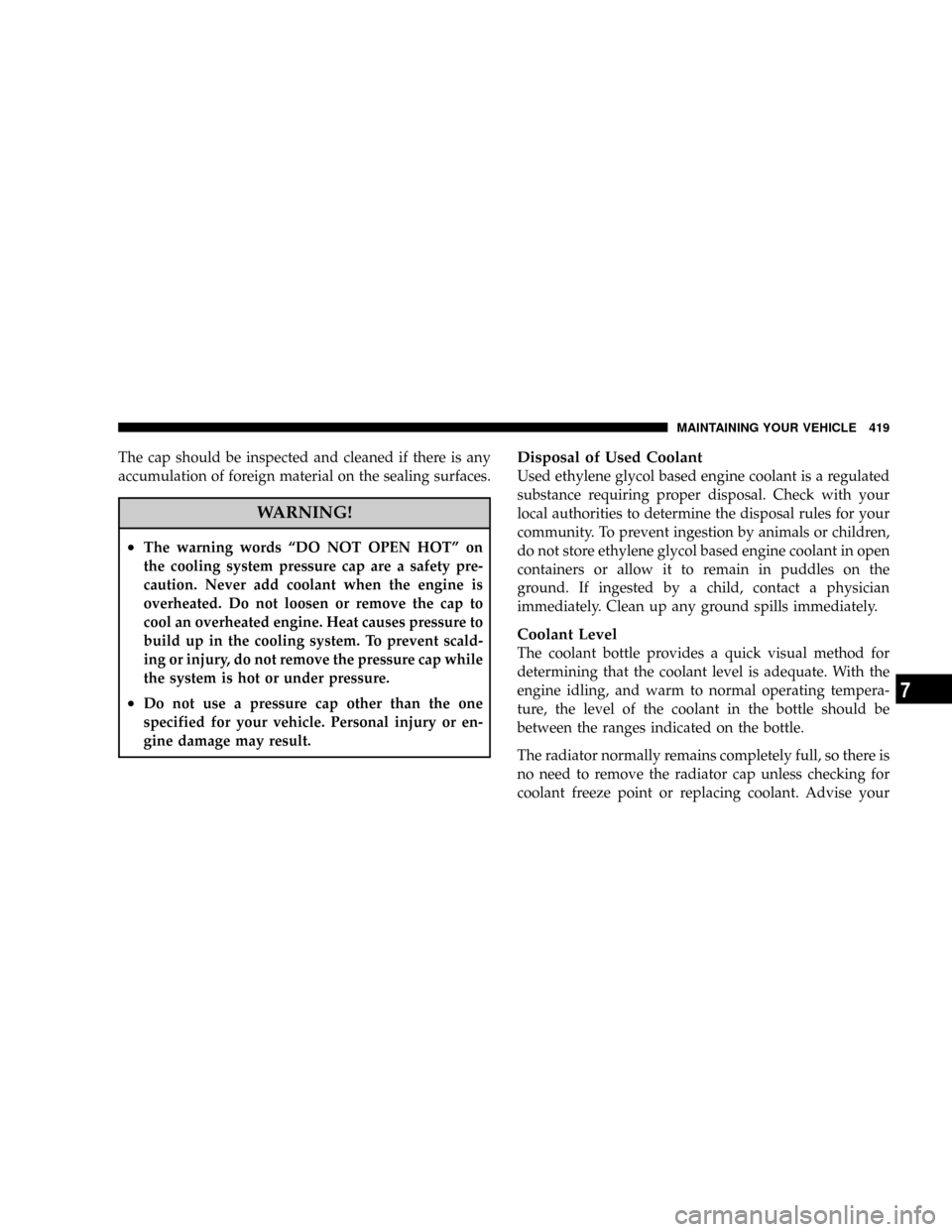
The cap should be inspected and cleaned if there is any
accumulation of foreign material on the sealing surfaces.
WARNING!
²The warning words ªDO NOT OPEN HOTº on
the cooling system pressure cap are a safety pre-
caution. Never add coolant when the engine is
overheated. Do not loosen or remove the cap to
cool an overheated engine. Heat causes pressure to
build up in the cooling system. To prevent scald-
ing or injury, do not remove the pressure cap while
the system is hot or under pressure.
²Do not use a pressure cap other than the one
specified for your vehicle. Personal injury or en-
gine damage may result.
Disposal of Used Coolant
Used ethylene glycol based engine coolant is a regulated
substance requiring proper disposal. Check with your
local authorities to determine the disposal rules for your
community. To prevent ingestion by animals or children,
do not store ethylene glycol based engine coolant in open
containers or allow it to remain in puddles on the
ground. If ingested by a child, contact a physician
immediately. Clean up any ground spills immediately.
Coolant Level
The coolant bottle provides a quick visual method for
determining that the coolant level is adequate. With the
engine idling, and warm to normal operating tempera-
ture, the level of the coolant in the bottle should be
between the ranges indicated on the bottle.
The radiator normally remains completely full, so there is
no need to remove the radiator cap unless checking for
coolant freeze point or replacing coolant. Advise your
MAINTAINING YOUR VEHICLE 419
7
Page 420 of 493

service attendant of this. As long as the engine operating
temperature is satisfactory, the coolant bottle need only
be checked once a month.
When additional coolant is needed to maintain the
proper level, it should be added to the coolant bottle. Do
not overfill.
Points To Remember
NOTE:When the vehicle is stopped after a few miles
(kilometers) of operation, you may observe vapor coming
from the front of the engine compartment. This is nor-
mally a result of moisture from rain, snow, or high
humidity accumulating on the radiator and being vapor-
ized when the thermostat opens, allowing hot coolant to
enter the radiator.
If an examination of your engine compartment shows no
evidence of radiator or hose leaks, the vehicle may be
safely driven. The vapor will soon dissipate.
²Do not overfill the coolant bottle.
²Check coolant freeze point in the radiator and in the
coolant recovery bottle. If coolant needs to be added,
contents of coolant recovery bottle must also be pro-
tected against freezing.
²If frequent coolant additions are required, or if the
level in the coolant recovery bottle does not drop when
the engine cools, the cooling system should be pres-
sure tested for leaks.
²Maintain coolant concentration at 50% HOAT engine
coolant (minimum) and distilled water for proper
corrosion protection of your engine, which contains
aluminum components.
²Make sure that the radiator and coolant recovery
bottle hoses are not kinked or obstructed.
420 MAINTAINING YOUR VEHICLE
Page 423 of 493
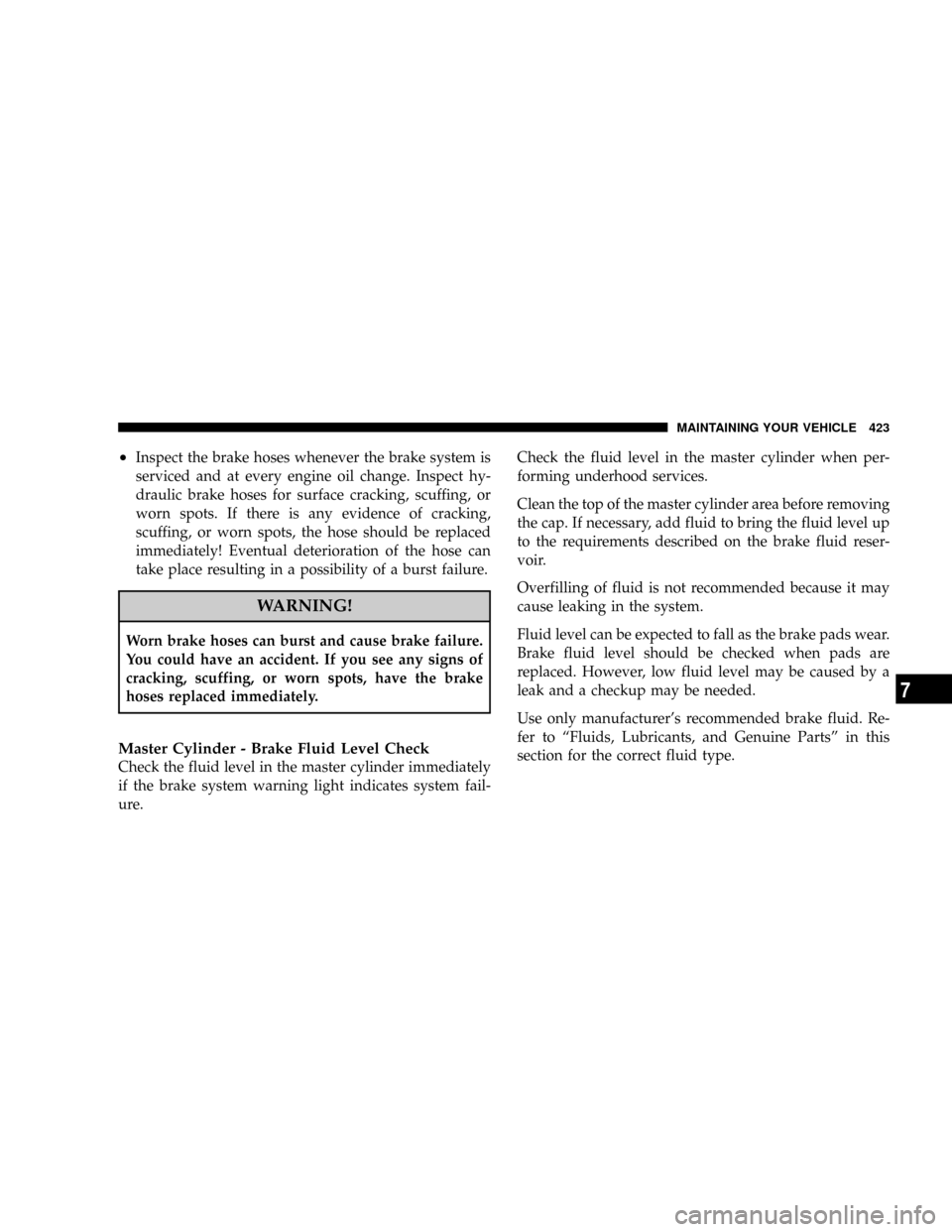
²Inspect the brake hoses whenever the brake system is
serviced and at every engine oil change. Inspect hy-
draulic brake hoses for surface cracking, scuffing, or
worn spots. If there is any evidence of cracking,
scuffing, or worn spots, the hose should be replaced
immediately! Eventual deterioration of the hose can
take place resulting in a possibility of a burst failure.
WARNING!
Worn brake hoses can burst and cause brake failure.
You could have an accident. If you see any signs of
cracking, scuffing, or worn spots, have the brake
hoses replaced immediately.
Master Cylinder - Brake Fluid Level Check
Check the fluid level in the master cylinder immediately
if the brake system warning light indicates system fail-
ure.Check the fluid level in the master cylinder when per-
forming underhood services.
Clean the top of the master cylinder area before removing
the cap. If necessary, add fluid to bring the fluid level up
to the requirements described on the brake fluid reser-
voir.
Overfilling of fluid is not recommended because it may
cause leaking in the system.
Fluid level can be expected to fall as the brake pads wear.
Brake fluid level should be checked when pads are
replaced. However, low fluid level may be caused by a
leak and a checkup may be needed.
Use only manufacturer's recommended brake fluid. Re-
fer to ªFluids, Lubricants, and Genuine Partsº in this
section for the correct fluid type.
MAINTAINING YOUR VEHICLE 423
7
Page 425 of 493
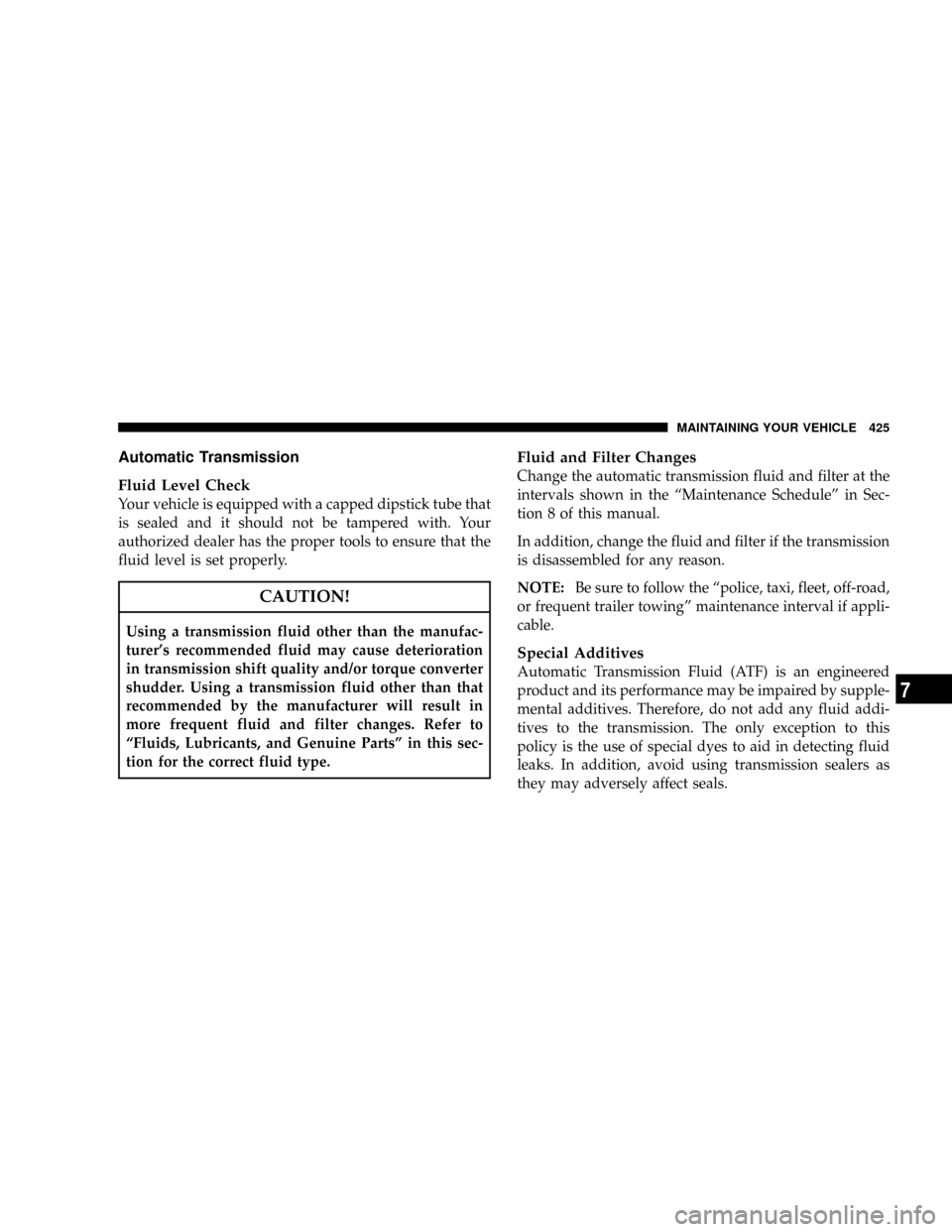
Automatic Transmission
Fluid Level Check
Your vehicle is equipped with a capped dipstick tube that
is sealed and it should not be tampered with. Your
authorized dealer has the proper tools to ensure that the
fluid level is set properly.
CAUTION!
Using a transmission fluid other than the manufac-
turer's recommended fluid may cause deterioration
in transmission shift quality and/or torque converter
shudder. Using a transmission fluid other than that
recommended by the manufacturer will result in
more frequent fluid and filter changes. Refer to
ªFluids, Lubricants, and Genuine Partsº in this sec-
tion for the correct fluid type.
Fluid and Filter Changes
Change the automatic transmission fluid and filter at the
intervals shown in the ªMaintenance Scheduleº in Sec-
tion 8 of this manual.
In addition, change the fluid and filter if the transmission
is disassembled for any reason.
NOTE:Be sure to follow the ªpolice, taxi, fleet, off-road,
or frequent trailer towingº maintenance interval if appli-
cable.
Special Additives
Automatic Transmission Fluid (ATF) is an engineered
product and its performance may be impaired by supple-
mental additives. Therefore, do not add any fluid addi-
tives to the transmission. The only exception to this
policy is the use of special dyes to aid in detecting fluid
leaks. In addition, avoid using transmission sealers as
they may adversely affect seals.
MAINTAINING YOUR VEHICLE 425
7
Page 453 of 493
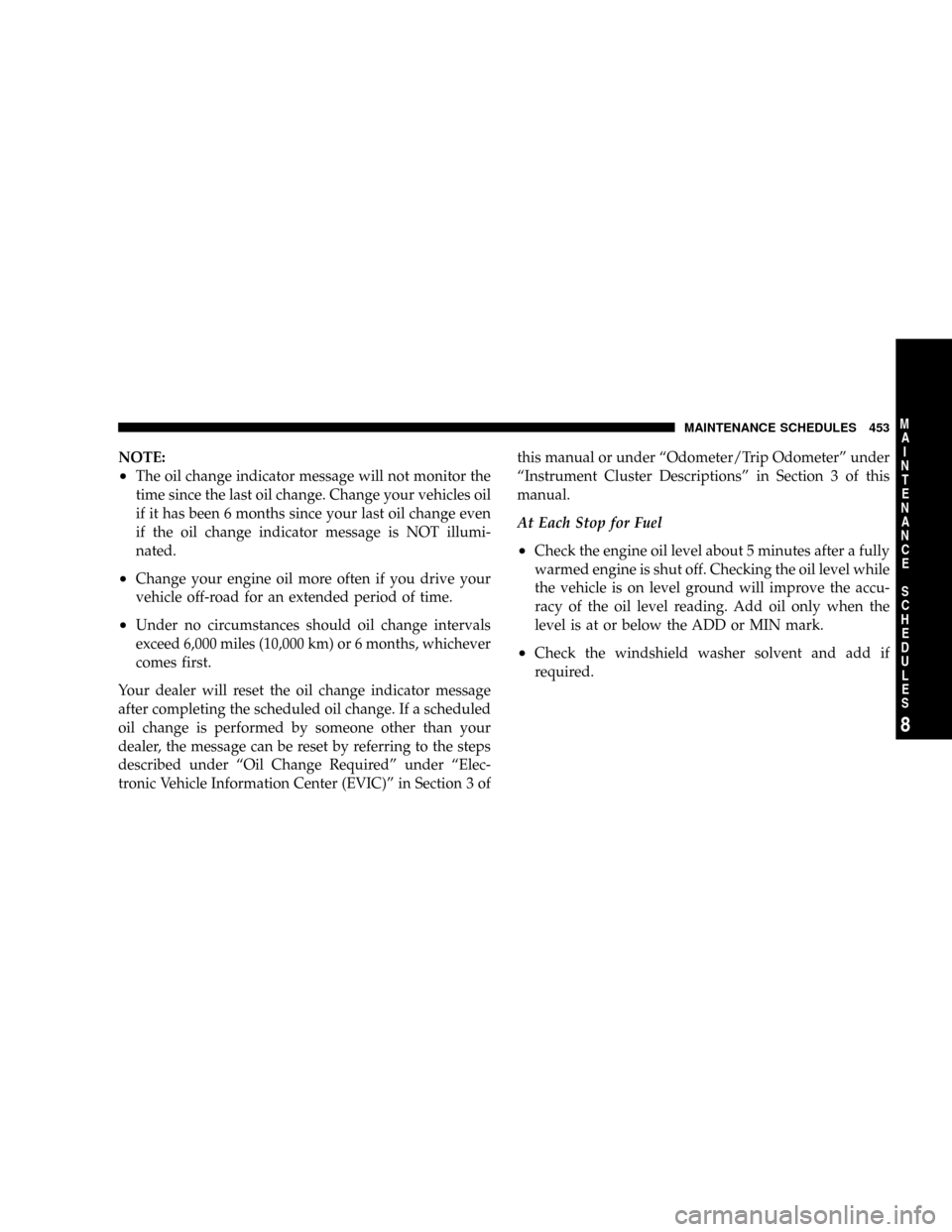
NOTE:
²The oil change indicator message will not monitor the
time since the last oil change. Change your vehicles oil
if it has been 6 months since your last oil change even
if the oil change indicator message is NOT illumi-
nated.
²Change your engine oil more often if you drive your
vehicle off-road for an extended period of time.
²Under no circumstances should oil change intervals
exceed 6,000 miles (10,000 km) or 6 months, whichever
comes first.
Your dealer will reset the oil change indicator message
after completing the scheduled oil change. If a scheduled
oil change is performed by someone other than your
dealer, the message can be reset by referring to the steps
described under ªOil Change Requiredº under ªElec-
tronic Vehicle Information Center (EVIC)º in Section 3 ofthis manual or under ªOdometer/Trip Odometerº under
ªInstrument Cluster Descriptionsº in Section 3 of this
manual.
At Each Stop for Fuel
²Check the engine oil level about 5 minutes after a fully
warmed engine is shut off. Checking the oil level while
the vehicle is on level ground will improve the accu-
racy of the oil level reading. Add oil only when the
level is at or below the ADD or MIN mark.
²Check the windshield washer solvent and add if
required.
MAINTENANCE SCHEDULES 453
8
M
A
I
N
T
E
N
A
N
C
E
S
C
H
E
D
U
L
E
S
Page 454 of 493

Once a Month
²Check tire pressure and look for unusual wear or
damage.
²Inspect the battery and clean and tighten the terminals
as required.
²Check the fluid levels of coolant reservoir, brake
master cylinder, and power steering, and add as
needed.
²Check all lights and other electrical items for correct
operation.At Each Oil Change
²Change the engine oil filter.
²Inspect the brake hoses and lines.
²Check the manual transmission fluid level.
CAUTION!
Failure to perform the required maintenance items
may result in damage to the vehicle.
454 MAINTENANCE SCHEDULES
8
M
A
I
N
T
E
N
A
N
C
E
S
C
H
E
D
U
L
E
S
Page 472 of 493

Brake, Parking.......................... 308
Brake System........................... 422
Anti-Lock (ABS)....................310,315
Fluid Check.......................423,449
Hoses.............................. 422
Master Cylinder....................... 423
Parking............................. 308
Warning Light........................ 202
Brakes............................... 422
Brake/Transmission Interlock............... 283
Break-In Recommendations, New Vehicle........ 79
Brightness, Interior Lights.................. 138
Bulb Replacement....................... 443
Bulbs, Light..........................82,443
Calibration, Compass..................204,212
Capacities, Fluid........................ 447
Caps, Filler
Fuel................................ 359Oil (Engine).......................... 404
Radiator (Coolant Pressure)............... 418
Car Washes............................ 429
Carbon Monoxide Warning...............80,358
Cargo Area Cover....................... 178
Cargo Area Features...................... 174
Cargo Compartment...................... 174
Light............................... 138
Cargo Light............................ 138
Cargo Load Floor........................ 174
Cargo Tie-Downs........................ 176
Cargo (Vehicle Loading)................... 361
Catalytic Converter...................... 407
CD (Compact Disc) Player................. 237
CD (Compact Disc) Player Maintenance........ 259
Cellular Phone.....................92,237,239
Certification Label....................... 361
Changing A Flat Tire..................... 385
Charging System Light.................... 194
472 INDEX
Page 473 of 493
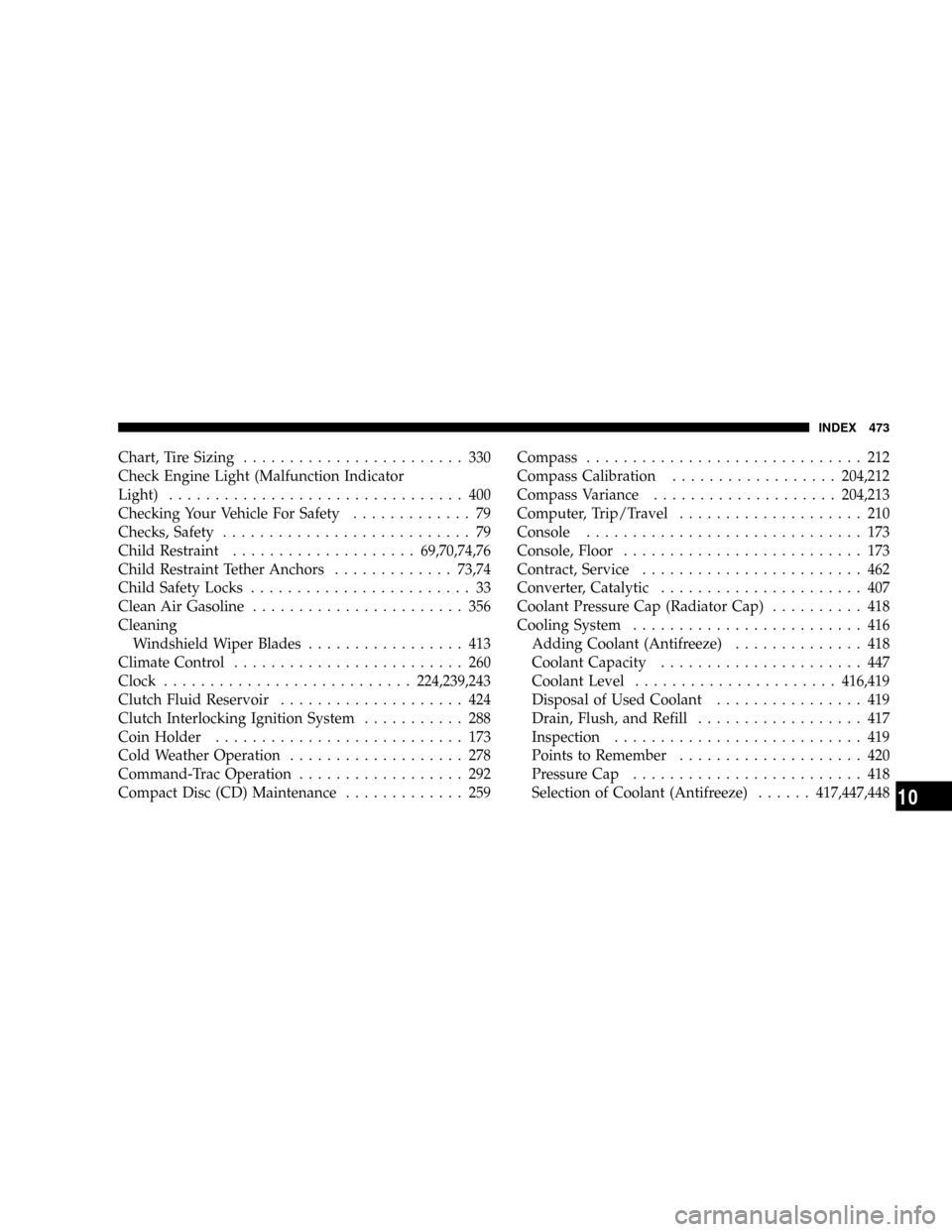
Chart, Tire Sizing........................ 330
Check Engine Light (Malfunction Indicator
Light)................................ 400
Checking Your Vehicle For Safety............. 79
Checks, Safety........................... 79
Child Restraint....................69,70,74,76
Child Restraint Tether Anchors.............73,74
Child Safety Locks........................ 33
Clean Air Gasoline....................... 356
Cleaning
Windshield Wiper Blades................. 413
Climate Control......................... 260
Clock...........................224,239,243
Clutch Fluid Reservoir.................... 424
Clutch Interlocking Ignition System........... 288
Coin Holder........................... 173
Cold Weather Operation................... 278
Command-Trac Operation.................. 292
Compact Disc (CD) Maintenance............. 259Compass.............................. 212
Compass Calibration..................204,212
Compass Variance....................204,213
Computer, Trip/Travel.................... 210
Console.............................. 173
Console, Floor.......................... 173
Contract, Service........................ 462
Converter, Catalytic...................... 407
Coolant Pressure Cap (Radiator Cap).......... 418
Cooling System......................... 416
Adding Coolant (Antifreeze).............. 418
Coolant Capacity...................... 447
Coolant Level......................416,419
Disposal of Used Coolant................ 419
Drain, Flush, and Refill.................. 417
Inspection........................... 419
Points to Remember.................... 420
Pressure Cap......................... 418
Selection of Coolant (Antifreeze)......417,447,448
INDEX 473
10